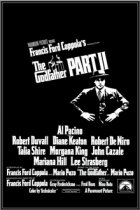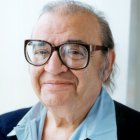
The Godfather: Part II
THE GODFATHER:
Part Two
Screenplay by
Mario Puzo
and
Francis Ford Coppola
SECOND DRAFT:
September 24, 1973
FADE IN:
The Paramount Pictures logo is presented over a simple black
background, as a single trumpet plays the familiar theme of
a waltz. White lettering fades in:
Mario Puzo's THE GODFATHER
There is a pause, as the trumpet concludes, and there is the
additional title: - Part Two -
INT. DON CORLEONE'S OLD OFFICE - CLOSE VIEW ON MICHAEL
CORLEONE - DAY
standing impassively, like a young Prince, recently crowned
King.
CLOSE VIEW ON Michael's hand. ROCCO LAMPONE kisses his hand.
Then it is taken away. We can SEE only the empty desk and
chair of Michael's father, Vito Corleone. We HEAR, over
this, very faintly a funeral dirge played in the distance,
as THE VIEW MOVES SLOWLY CLOSER to the empty desk and chair.
DISSOLVE TO:
EXT. A SICILIAN LANDSCAPE - FULL VIEW - DAY
We can barely make out the funeral procession passing over
the burnt-brown of a dry river bed. The figures move
slowly, seemingly from out of hundreds of years of the past.
The MUSICIANS walking unsteadily on the rocky bed, their
instruments harsh and blaring.
They are followed by six young peasant men, carrying the
crude wooden coffin on their shoulders. Then the widow, a
strong large woman, dressed in black, and not accepting the
arms of those walking with her.
Behind her, not more than twenty relatives, few children and
paisani continue alone behind the coffin.
Suddenly, we HEAR the shots of the lupara, and the musicians
stop their playing. The entire procession scatters in odd
directions along the rocky river bed.
The young men struggle with the burden of the heavy coffin,
throwing it out of balance and nearly crashing to the ground.
We hear a woman SCREAMING:
WOMAN:
(Sicilian)
They've killed young Paolo! They've
killed the boy Paolo!
EXT. SICILIAN LANDSCAPE - MED. VIEW - DAY
across the slain body of a fourteen year old boy, lying on
the parched ground. In the distance we see four or five of
the mourning women, the wind blowing their black dresses and
veils, running up to the body of the boy. They begin to
wail, and cry out in anguished Sicilian, as the widow, the
mother of the murdered boy, holds her child in her arms, his
fresh blood wetting her strong hands.
EXT. BARONIAL ESTATE - TIGHT MOVING VIEW - DAY
A boy, eight or nine, with wide, frightened eyes, being
pulled quickly by the hand. This is VITO ANDOLINI, who is
to become The Godfather.
The VIEW ALTERS revealing that he is being pulled along by
his Mother, the Widow, across a field leading to the
ornamental gates of a Baronial Estate of some forgotten Noble.
At various positions near the gates are men with shotguns,
or lupara. The gates are opened; and the Widow and her boy
are shown before DON FRANCESCO, a man in his sixties. He
wears his trousers with suspenders, and an open white shirt
sloppily tucked in over his enormous belly. He wears a hat
to protect him from the white-hot sun, and proudly displays
a gold watch and chain over his vest.
He sits in a chair, near a group of his men in the garden,
listening to the Widow, who stands before him with her only
son.
WIDOW:
(Sicilian)
Don Francesco. You murdered my
husband, because he would not bend.
And his oldest son Paolo, because
he swore revenge. But Vitone is
only nine, and dumb-witted. He
never speaks.
DON FRANCESCO:
(Sicilian)
I'm not afraid of his words.
WIDOW:
(Sicilian)
He is weak.
DON FRANCESCO:
(Sicilian)
He will grow strong.
WIDOW:
(Sicilian)
The child cannot harm you.
DON FRANCESCO:
(Sicilian)
He will be a man, and then he will
come for revenge.
As she pleads, the Widow moves closer to the Don, until she
has practically thrown herself to her knees before him.
WIDOW:
(Sicilian)
I beg you, Don Francesco, spare my
only son. He is all I have. In
the name of the Holy Spirit, I
swear he will never be a danger to
you...
Suddenly, she reaches under her skirt, where she has hidden
a kitchen knife.
WIDOW:
(continuing)
But I will kill you myself!
(she lunges at the
Mafia chieftain)
Vitone, go!
The boy runs as fast as he can out through the gates. Then
there is a lupara blast. He turns, and sees his Mother
flung a distance of five feet from the short range of the
terrible blast of the shotgun. Then he sees the men turn
their attention to him. One fires at him; but the boy is
quick, and disappears into a grove of olive trees.
EXT. STREETS OF CORLEONE - NIGHT
Two men roam the deserted streets of Corleone, carrying
lupare. Every so often, they stop, and one shouts in a
loud, almost singsong voice, like a fish peddler. Their
names are MOSCA and STROLLO.
MOSCA:
(Sicilian)
Our Friend promises misery to
anyone who harbors the boy Vito
Andolini.
(he turns and shouts
in the other direction)
Our Friend promises misery to
anyone who harbors the boy Vito
Andolini.
INT. A HOUSE - NIGHT
A family quietly eats their dinner. The father is the local
policeman, as indicated by his uniform jacket and gun,
hanging nearby.
STROLLO:
(Sicilian, O.S.)
Our Friend will be hard with any
family who gives help to Vito
Andolini.
One of the children looks up, about to speak. But the
father sternly indicates that nothing must be said. They go
on with their dinner.
EXT. THE STREETS OF CORLEONE - FULL VIEW - NIGHT
The men continue walking up and throughout the streets, far
in the distance.
MOSCA:
(Sicilian O.S.)
...misery to any family who harbors
the boy, Vito...
INT. A BARN - NIGHT
Four little girls watch with wide eyes as their mother and
father bind Vito tightly in swaddled cloth, and then lift
him up to the side of a mule; counter-balancing a heavy load
of firewood. The father looks at the boy's almost stoically
calm little face.
FATHER:
(Sicilian)
Vito...We pray for you.
He pulls the fabric over the boy's face.
MOSCA:
(Sicilian O.S.)
...Andolini...
STROLLO:
(Sicilian O.S.)
Our Friend promises misery to any
family...
The men continue on their night-walk, up to the plaza of the
church.
STROLLO:
(Sicilian)
...who harbors the boy Vitone
Andolini.
The figure of a single man on a mule passes them.
MOSCA:
(Sicilian)
Let no one give help to the boy
Vito Andolini...
The man on the mule makes his way out of the village and
disappears into the distance.
We begin to hear, very quietly, the Waltz repeated once again.
EXT. STEAMSHIP - CLOSE VIEW ON VITO - DAY
huddled in blankets, on the deck of the ship in Steerage.
He does not say a word. The Waltz grows louder as the VIEW
ALTERS, revealing the hundreds of immigrant families huddled
together with all their earthly possessions on their way to
America.
Then, suddenly, the Waltz stops.
THE NEW YORK HARBOR - DAY
SILENCE. We glide past the Statue of Liberty.
VIEW on the IMMIGRANTS standing on shipboard silently;
looking. Vito is standing with them, his eyes wide.
Translation
Translate and read this script in other languages:
Select another language:
- - Select -
- 简体中文 (Chinese - Simplified)
- 繁體中文 (Chinese - Traditional)
- Español (Spanish)
- Esperanto (Esperanto)
- 日本語 (Japanese)
- Português (Portuguese)
- Deutsch (German)
- العربية (Arabic)
- Français (French)
- Русский (Russian)
- ಕನ್ನಡ (Kannada)
- 한국어 (Korean)
- עברית (Hebrew)
- Gaeilge (Irish)
- Українська (Ukrainian)
- اردو (Urdu)
- Magyar (Hungarian)
- मानक हिन्दी (Hindi)
- Indonesia (Indonesian)
- Italiano (Italian)
- தமிழ் (Tamil)
- Türkçe (Turkish)
- తెలుగు (Telugu)
- ภาษาไทย (Thai)
- Tiếng Việt (Vietnamese)
- Čeština (Czech)
- Polski (Polish)
- Bahasa Indonesia (Indonesian)
- Românește (Romanian)
- Nederlands (Dutch)
- Ελληνικά (Greek)
- Latinum (Latin)
- Svenska (Swedish)
- Dansk (Danish)
- Suomi (Finnish)
- فارسی (Persian)
- ייִדיש (Yiddish)
- հայերեն (Armenian)
- Norsk (Norwegian)
- English (English)
Citation
Use the citation below to add this screenplay to your bibliography:
Style:MLAChicagoAPA
"The Godfather: Part II" Scripts.com. STANDS4 LLC, 2025. Web. 22 Jan. 2025. <https://www.scripts.com/script/the_godfather:_part_ii_101>.







Discuss this script with the community:
Report Comment
We're doing our best to make sure our content is useful, accurate and safe.
If by any chance you spot an inappropriate comment while navigating through our website please use this form to let us know, and we'll take care of it shortly.
Attachment
You need to be logged in to favorite.
Log In